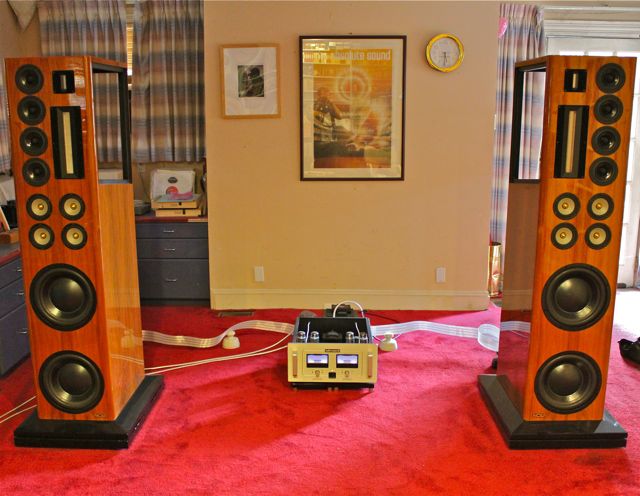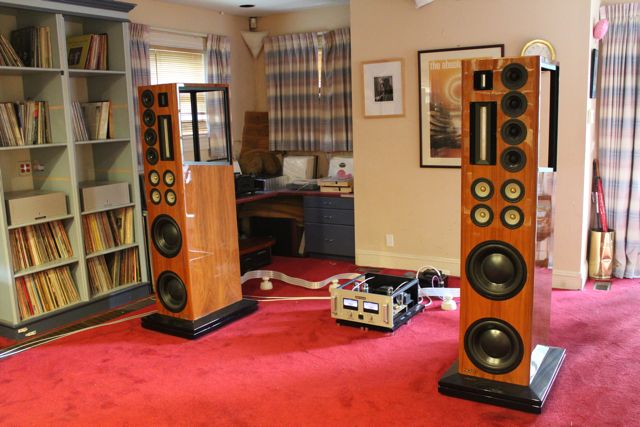
NOLA Concert Grand Reference Gold Loudspeakers

These new giant speakers from Carl Marchisotto, of Alon and now NOLA fame, have made me question what I once thought possible. What it does, it does without calling attention to itself. The sound is seamless, the defining feature of what I consider a true reference component.
Listening to "Pictures at an Exhibition" I finally heard the great gate of Kiev. I saw it. The power of the orchestra comes through without any hesitation. There is a real passion at play here. If you have been searching for what I have (sonically speaking), then you owe it to yourself to hear what these speakers can do.
I have put "Un Bal" through a thousand incarnations but have yet to hear it as lifelike as we are hearing it now. These speakers give me a reference from which I can adjudge the sonics of my system, my recordings, and of course, all other components that may cross my path. Somehow Carl has entered the golden years of his speaker design and the Concert Grand's are his masterpiece.
On "Saturn" (Holst, The Planets XRCD) you hear everything. You hear the bells, you hear the decay, the attack, and beneath it the bass, but they are never blended together. The sounds, the individual instruments, are never mixed up. I am hearing differentiations that I have never heard before, and I know this track better than myself. How did they get bass so clean and keep the highs so exquisite? All I can really say that it is right, absolutely right. Carl's giant creations are democratic in their representation of the sonic spectrum from the top on down.
When I listen to these speakers I hear the music, and only the music, and there is really nothing more to say than that.
~HP

The NOLA Concert Grand Reference Gold loudspeakers give you everything you could possibly want from a large "super" speaker. They are dynamic as hell and have a massive soundstage. They push enough air on loud passages to convince your insides that an actual orchestra of humans set up shop in your listening room. But where the CGRG stands alone is the ability to properly, and thoroughly, reproduce all variations of music, including the smaller, the softer, and more delicate moments.
They provide appropriate and accurate image size on solo voice and smaller groups, a most difficult task for large loudspeakers. They sound as fluidly natural on soft and delicate passages as they do on the fireworks (and they will knock you flat on the loud, dynamic, demanding stuff). Typically, mega-speakers are most suitable for "large scale works", to be played at loud levels, because these speakers always sound "large" (this is the trade-off). But this tendency to produce "large" sounds occur even when the program is a "smaller" source, stripping away the natural elements, taking you away from the source.
According to Carl Marchisotto, the owner and designer at NOLA, the CGRG was developed to "provided detail at realistic levels". Citing that many speakers need to be played well above "live concert volumes" in order to provide significant detail, Marchisotto "concentrated on preserving the low level detail and also the jump factor. This so-called "jump factor" is directly related to speed and therefore, dynamic energy." In other words -- how fast the speaker can go from ppp to fff. The effect of a large speaker capturing such intricate dynamics can be startling, and with the CGRG, this ability contributes to the overall "aliveness" we have been experiencing on our favorite recordings.
The CGRG is quite the model of efficiency, with easy-to-drive impedance (no 2-ohm loads here), so that even moderate power amplifiers of 75-watts can easily drive them to concert levels (thus, the ARC REF-75, which we have recently been using as our go-to reference amplifier). Many speakers today are designed to be 4-ohms in order to maximize solid-state amplification (and, quite possibly, to make the specs look more impressive). The CGRG is 91dB at 8 ohms. Marchisotto decided that his statement speaker would need to be easy to drive because he wanted to get "more music out of it."
The CGRG is an all-passive system with the 12 drivers per channel controlled by the NOLA custom, five-way Unison five-board crossover system. The drivers in the CGRG are all proprietary. The 12" subwoofer drivers are low mass designs with extended response to 1000 Hz, without the crossover (and they are only used below 40 Hz) -- which is quite fast for a subwoofer driver. The CGRG do not incorporate 15" or 18" subs, because, according to Marchisotto, "they are too slow to blend with the rest of the design." There are four, 120mm (4 ½") bass drivers, which have a slim seven grams of moving mass (compared to the typical 30 grams or more for standard woofers). The Alnico magnet system, along with the gold plated copper phase plugs, are in place to help remove any and all dynamic coloration (which can be a common problem with many woofer systems). There are four, 110mm open-baffle dipole midranges with tri-laminate cones and a pulp bass. Marchisotto chose these because he found they provide the "most natural midrange sound". (These midrange drivers are also driven by Alnico magnet systems.)
The midrange system operates as a short line source and the main tweeter is a line source ribbon design. It is a true ribbon, 12 inches long, with no extra diaphragm. This driver alone weighs 25 pounds and utilizes a significant amount of neodymium magnets. The output of the line source tweeter is supplemented at frequencies above 15 kHz by a true ribbon super tweeter. According to Marchisotto, this driver "helps improve the high frequency dispersion of the entire system."
So, how does it sound? Like music. Like the real thing. This speaker captures bloom and transparency at the same time, a rarity for such a large transducer. The individual notes bloom without washing over delicate passages. The music just seems to flow through you. The speakers compliment every style of music. They are at home reproducing Carnegie Hall, Abbey Road Studios, RCA's Studio B, or Wally Heiders. Electric music comes through with blazing power and tone. Orchestras are massive with dynamics, presence, and deep realism. Jazz quartets are intimate and natural. Every instrument, every human for that matter, is in the right place. The music does not need to be played at extremely loud levels in order to produce a large soundstage (read: realistic) and this allows the speakers, however massive in physical stature, to disappear. As HP says, "they are there, but they are not there."
The Scaenas have been a large-speaker reference for some time now, and they still are, but the NOLAs are a completely different animal. The Scaenas were king when it came to three-dimensionality, but the NOLAs are seamless in a way that I have yet to experience. They give the music a living presence every single time.
I asked Marchisotto why he would want to build such an expensive speaker. He explained, "the Concert Grand Reference Gold is a platform where we can demonstrate our technology with the best possible implementation. What we find here is that even with modest sources, the results can be extraordinary. We therefore can separate loudspeaker problems from system problems in evaluating the performance of our lesser models. Without the availability of the CGRG used as a reference, this would be much more difficult."
He continues, "a significant challenge was to see if we could equal the musicality of our four tower Grand Reference VI Gold, in a two-tower format. The CGRG will perform in a much larger variety of spaces than the four-tower system, and this makes it more relevant in terms of its performance. Another reason is the "trickle down" concept. We learn techniques when developing the ultimate models that can be applied to lesser models. There would not be a KO model with its outstanding performance at its price, were it not for the development of our ultimate models."
Given the price tag, it is perhaps more pertinent to say that these are a "must hear" product over a "must have" one (although, if price is no matter, these are most definitely a must have). Meaning: These speakers will provide you with a musical reference that you will hold for the rest of your life, giving you a benchmark of what is possible, allowing your perceptions of what recorded sound sounds like to shatter and rebuilt anew.
There are many speakers available in this elite class of six-figure loudspeakers, the luxury end of audio, so there is no need to chastise NOLA alone for offering a product so few can obtain (there are countless audio components that are designed for the exclusive few, including the rare one-off). The fact that NOLA uses the technology and research developed for its flagship speakers to infiltrate their less expensive, smaller designs (such as the Boxer and KO) is clearly evident, in design and the sound. The Concert Grand's are the obvious highlight in NOLA's two-tower system (there is a four-tower version available with dedicated Subwoofer towers), but listen to any of the recent NOLA speakers and you will hear the same defining feature -- they breathe music, effortlessly. Listening to these speakers have be a revelation.
~JSW